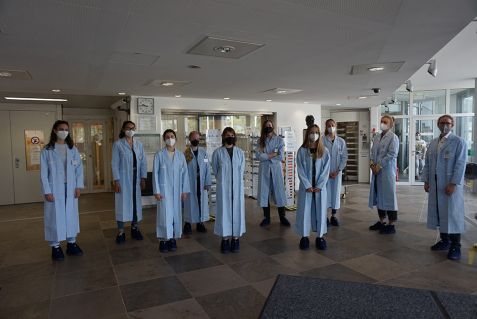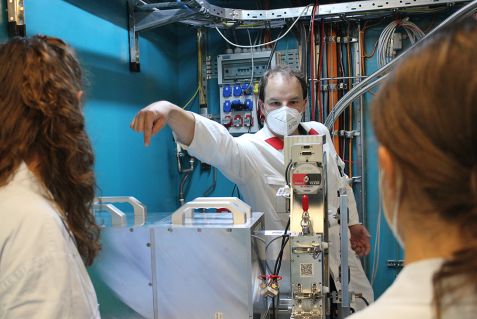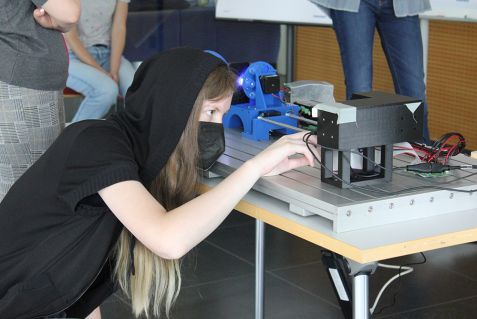MLZ is a cooperation between:
 > Technische Universität München
> Technische Universität München > Helmholtz-Zentrum Hereon
> Helmholtz-Zentrum Hereon
 > Forschungszentrum Jülich
> Forschungszentrum Jülich
MLZ is a member of:
 > LENS
> LENS > ERF-AISBL
> ERF-AISBL
MLZ on social media:

MLZ (eng)
Lichtenbergstr.1
85748 Garching
16.08.2021
Explorers at the neutron source
Girls and young women experienced the world of natural sciences firsthand at the research neutron source Heinz Maier-Leibnitz (FRM II). As one of a total of 17 projects, the course “Flight, Materials, Radiation” brought together eight TUM explorers from all over Bavaria.
Flying, materials, and radiation – these three exciting topics were the focus of a two-day STEM project for eight TUM explorers at the Technical University of Munich (TUM) from August 2 – 3. On the first day, the young women took to the skies at the Department of Aerospace and Geodesy: they were able to demonstrate their skills as pilots in a flight simulator. Afterwards, they were given an insight into materials science by casting an object out of metal themselves at the Chair of Metal Forming and Casting (utg).
What, how, why – many questions about neutron research

Eight TUM explorers visited the research neutron source Heinz Maier-Leibnitz together with the TUM project organizers Anna Reif (l.) and Robert Graner (r.). © FRM II / TUM
The second day at TUM was dedicated to neutron research. For this purpose, the school students, who had traveled from as far as the Upper Palatinate to Garching, visited the Heinz Maier-Leibnitz research neutron source. During a guided tour of the research reactor, the view of the reactor pool from the visitors’ window was impressive. “How does a stable chain reaction take place?”, “What safety systems are there?”, “How can you imagine studying physics?” and “Why is it actually so warm in the reactor building?” – the interested visitors questioned their guides Tobias Neuwirth and Alexander Backs, both PhD students at the ANTARES neutron radiography facility.
Countless cables and interesting instruments

PhD student Tobias Neuwirth shows the school students the neutron radiography facility ANTARES in the experimental hall. © FRM II / TUM
In the experimental hall, the explorers then visited some scientific instruments. “How can you keep track of so many cables?” one visitor exclaimed, surprised by the number of instruments and experimental setups. The young scientists took a close look at ANTARES during their tour. This instrument allows researchers to look inside metal parts and observe the movement of liquids or lubricants in these components. Non-destructive testing also makes it possible to detect cracks or cavities that are not visible from the outside.
Neutron research on the 3D model
And what would such a non-destructive component examination look like in reality? That was quickly explained: At a 3D miniature model of ANTARES, the TUM explorers were able to lend a hand themselves and understand how the instrument works with a beam of light simulating a neutron beam. For some of the young women, the visit to the neutron source confirmed their career aspirations: “It will definitely be something in the STEM field! It’s just exciting.”
More information:
TUM Entdeckerinnen (TUM explorers) is a program of the Technical University of Munich (TUM) to promote young talent in the STEM subjects of mathematics, computer science, natural sciences and technology. The projects as part of “MINT-Erlebnis an der Uni” (STEM experience at the university) are offered during the Bavarian summer vacations at all TUM locations. In hands-on courses, girls and young women are offered an insight into the various STEM subjects.
MLZ is a cooperation between:
 > Technische Universität München
> Technische Universität München > Helmholtz-Zentrum Hereon
> Helmholtz-Zentrum Hereon
 > Forschungszentrum Jülich
> Forschungszentrum Jülich
MLZ is a member of:
 > LENS
> LENS > ERF-AISBL
> ERF-AISBL
MLZ on social media:



